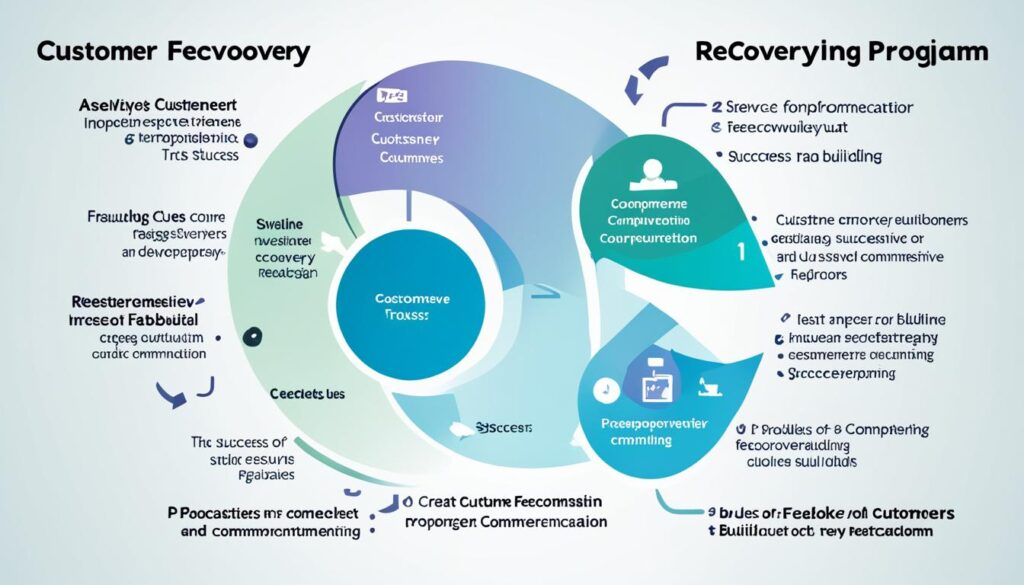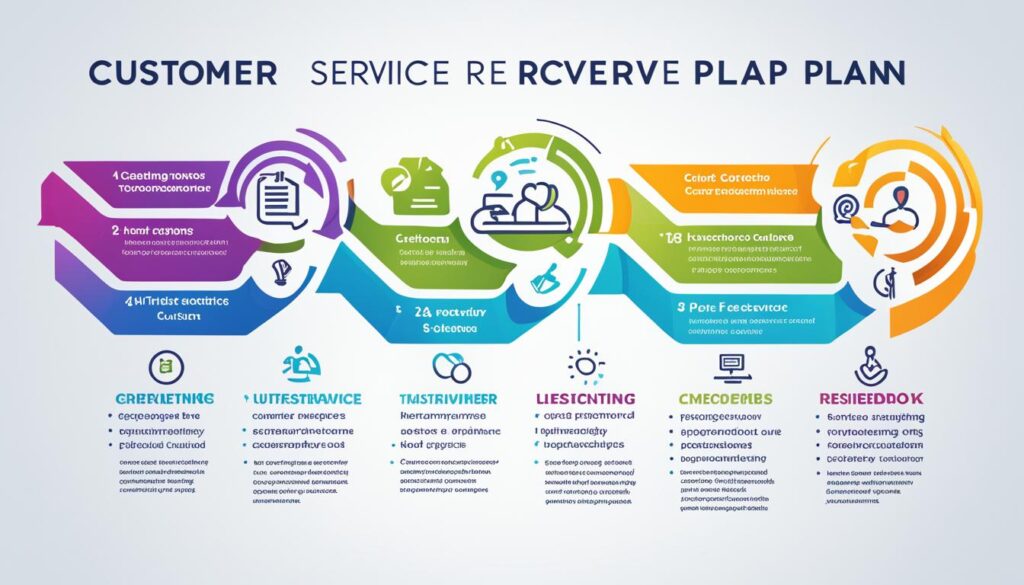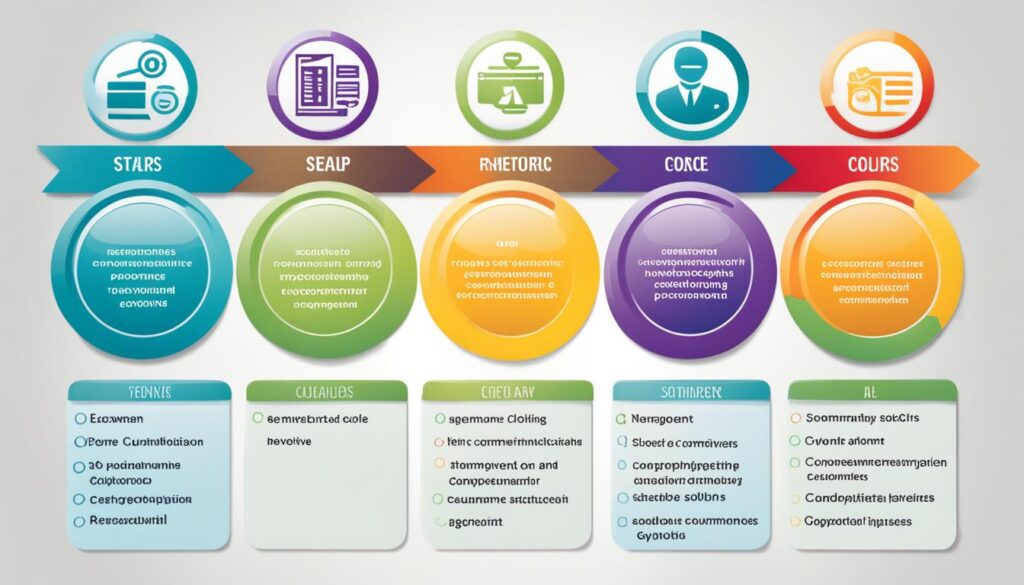If you want to boost customer loyalty and satisfaction, building a service recovery program is essential. When negative experiences occur, it’s crucial to address them promptly and effectively. By following these six steps, you can create a service recovery program that not only resolves customer issues but also strengthens your customer relationships.
It’s important to note that a service recovery program is designed to rectify negative service experiences, ultimately saving customer relationships and improving customer retention. When customers feel their complaints are handled well, they are more likely to trust and remain loyal to your business.
What is Service Recovery and Why is it Important?
Service recovery is a crucial process that involves rectifying a negative service experience for a customer. It plays a vital role in maintaining customer satisfaction, loyalty, and retention for businesses. When customers encounter issues or have complaints, how these concerns are addressed can significantly impact their overall satisfaction and future relationship with the brand.
Implementing a service recovery program enables businesses to effectively handle customer complaints and resolve problems in a timely and satisfactory manner. By doing so, companies can meet customer expectations and prevent customer churn. Service recovery affords the opportunity to turn negative experiences into positive ones, salvaging customer relationships and contributing to long-term loyalty.
A successful service recovery program shows customers that their concerns are valued and prioritized. It demonstrates that the business is committed to resolving issues promptly and providing a high level of service. This, in turn, fosters trust, enhances customer satisfaction, and strengthens the overall customer experience.
Importance of Customer Satisfaction and Loyalty
Customer satisfaction is a critical factor in maintaining a positive brand image and attracting repeat business. When businesses prioritize service recovery, they are more likely to achieve higher levels of customer satisfaction. Satisfied customers are more likely to become loyal advocates for the brand, recommending it to others and contributing to positive word-of-mouth marketing.
In the words of Jeff Bezos, founder of Amazon:
“We see our customers as invited guests to a party, and we are the hosts. It’s our job every day to make every important aspect of the customer experience a little bit better.”
By actively addressing customer concerns, businesses can save valuable relationships, prevent negative reviews, and mitigate potential damage to their reputation. Research shows that loyal customers are more profitable, make repeat purchases, and are more likely to forgive occasional service failures when those failures are addressed promptly and efficiently.
Ultimately, a strong service recovery program leads to improved customer retention rates and increased customer loyalty. It is an essential aspect of any customer-centric business strategy, allowing companies to build lasting relationships and secure a competitive advantage in the market.
Service Recovery Strategies and Steps
To build an effective service recovery program, there are six key strategies and steps that you should follow:
- Get leadership buy-in: Convince company leaders of the importance of service recovery and the potential impact on customer retention and revenue.
- Establish recovery criteria: Define specific criteria that will flag an interaction or customer complaint for service recovery.
- Create your service recovery team: Determine who will be responsible for handling service recovery tickets and addressing customer complaints.
- Determine protocol: Set clear guidelines for how to handle different types of negative interactions and provide standards for each situation.
- Re-survey the customer: After resolving the issue, send a follow-up feedback request to measure the impact of the service recovery efforts and ensure customer satisfaction.
- Measure impact over time: Continuously evaluate the success of the service recovery program by tracking customer retention and satisfaction metrics.
Implementing these strategies and steps will help you effectively address customer feedback, complaints, and enhance the overall quality of your customer service. By prioritizing service recovery, you can improve customer retention and satisfaction, building stronger relationships with your valuable customers.

Remember, customer satisfaction and retention are crucial for the success of your business. By proactively implementing service recovery strategies and steps, you can resolve issues and turn negative experiences into positive ones, ultimately fostering long-term loyalty and growth.
Examples of Service Recovery Situations
Service recovery is essential in various situations that involve customer complaints, negative service experiences, and dissatisfaction. Effective service recovery can help address these issues promptly and effectively, ensuring customer satisfaction and loyalty. Here are some common examples of service recovery situations:
-
Complaints on social media: When customers express their dissatisfaction on platforms like Twitter, Facebook, or Instagram, it’s important to respond quickly and publicly. By acknowledging their concerns and offering a resolution, you demonstrate your commitment to customer service and show potential customers that you value their feedback.
-
Negative reviews on third-party websites: If a customer leaves a negative review on a popular review site, it’s crucial to address their concerns. Responding professionally and offering a solution can not only resolve the issue with that specific customer but also show other potential customers that you take feedback seriously and are proactive in addressing problems.
-
Low scores on customer satisfaction surveys: When customers provide low scores on satisfaction surveys, it indicates that they were not pleased with their experience. Following up with these customers to understand their concerns and offering appropriate compensation or solutions can help turn their negative experience into a positive one and improve their overall perception of your brand.
-
Expressions of anger during interactions: Occasionally, customers may express their frustration or anger during interactions with your customer service team. It’s important to remain calm, empathize with their concerns, and actively work towards finding a satisfactory solution. By doing so, you show that you genuinely care about their experience and are committed to resolving their issues.
-
Negative feedback on feedback forms: If customers provide negative feedback through feedback forms, it’s essential to address their concerns promptly. By acknowledging their feedback and taking appropriate action, you demonstrate your commitment to continuous improvement and showcase your dedication to providing exceptional customer service.
-
Unmet customer expectations: Sometimes, customers may have certain expectations that are not met during their interaction with your business. This could be due to miscommunication, misunderstandings, or other factors. By identifying the gap between their expectations and their actual experience, you can take steps to address their concerns and find a suitable resolution.
These examples highlight the importance of promptly addressing customer complaints and implementing effective service recovery strategies. By proactively handling service recovery situations, businesses can turn negative experiences into positive ones, enhance customer satisfaction, and build long-lasting customer relationships.
Building an Effective Customer Service Recovery Plan for Small Businesses
As a small business, it’s crucial to have an effective customer service recovery plan in place to address customer complaints and resolve issues promptly. By implementing a well-designed plan, you can ensure customer satisfaction, maintain their loyalty, and safeguard your business’s reputation. Here are the essential steps to include in your customer service recovery plan:
- Identify the Problem: Listen carefully to the customer’s complaint and fully understand the issue they are facing. Acknowledge their concerns and let them know that you are committed to finding a solution.
- Apologize to the Customer: Take responsibility for the problem and provide a sincere apology. Show empathy towards the customer’s experience and assure them that you will do everything possible to make it right.
- Offer a Solution: Propose a practical solution that addresses the customer’s complaint. Be transparent about the steps you will take to resolve the issue and provide a timeline if necessary.
- Follow up with the Customer: After implementing the solution, reach out to the customer to ensure their satisfaction. Ask for feedback to confirm that their issue has been resolved to their expectations.
- Learn from the Experience: Evaluate the root cause of the problem and identify areas for improvement in your products, services, or business processes. Use the customer’s feedback to learn and prevent similar issues from occurring in the future.
- Reward the Customer: As a gesture of goodwill, consider offering a small token of appreciation such as a discount, gift, or exclusive offer to express gratitude for the customer’s patience and loyalty.
By implementing these steps into your customer service recovery plan, you can effectively address customer complaints, resolve issues promptly, and maintain high levels of customer satisfaction and loyalty. Remember, every customer interaction is an opportunity to strengthen your relationship with them and enhance your small business’s reputation.

Image: An illustration of a customer service agent resolving a customer’s complaint.
Strategies for Service Recovery and Customer Loyalty
Service recovery strategies are vital in cultivating customer loyalty and transforming negative experiences into positive ones. By implementing effective complaint handling techniques and customer advocacy practices, businesses can enhance customer satisfaction and strengthen their relationships with their clientele.
One crucial aspect of service recovery is apologizing sincerely to the customer. Expressing genuine remorse for any service failure demonstrates empathy and acknowledges the customer’s feelings, laying the foundation for a successful recovery. Taking ownership of the problem further reinforces this commitment to resolve the issue.
Identifying the root cause of the problem is equally important when implementing service recovery strategies. By understanding the underlying factors that led to the service failure, businesses can formulate appropriate solutions tailored to address the specific issue and prevent future occurrences.
The key to effective service recovery lies in solving the problem swiftly and efficiently. Promptly resolving the customer’s complaint demonstrates responsiveness and a commitment to their satisfaction.
Going the extra mile by offering something extra can leave a lasting positive impression on the customer. Whether it’s a discount, a free product or service, or any other gesture of goodwill, this act of generosity can not only resolve the current issue but also build customer loyalty for the long term.
- Apologize sincerely
- Take ownership of the problem
- Get to the root of the issue
- Solve the problem promptly
- Offer something extra
- Follow up with the customer
The service recovery paradox is a phenomenon that demonstrates how successful service recovery efforts can actually increase customer loyalty. When businesses effectively handle and resolve service failures, customers often develop a higher level of trust and satisfaction, resulting in stronger loyalty towards the brand.
To sum up, by implementing service recovery strategies that focus on complaint handling, customer advocacy, and customer satisfaction, businesses can not only address service failures effectively but also strengthen customer loyalty and enhance their overall reputation. These strategies create opportunities to turn negative experiences into positive ones, fostering long-term customer relationships.

Conclusion
Building a service recovery program and implementing effective strategies can significantly enhance customer loyalty and satisfaction. By following the six steps outlined in this article, businesses can address negative customer experiences, meet customer expectations, and build stronger relationships with their customers. Prioritizing service recovery and continually improving the customer service process is a key aspect of maintaining customer loyalty and ensuring business success.
Customer service recovery is crucial for businesses of all sizes. It allows companies to address and resolve customer complaints, ensuring customer satisfaction and retention. By developing a comprehensive service recovery program, businesses can recover from service failures, saving valuable customer relationships. Effective recovery strategies, such as apologizing sincerely and taking ownership of problems, can turn a negative experience into a positive one, boosting customer loyalty in the process.
Enhancing customer loyalty goes hand in hand with providing exceptional customer service. When businesses prioritize customer service recovery, they demonstrate their commitment to meeting customer needs and resolving issues promptly. A well-established service recovery program not only improves customer satisfaction but also strengthens the bond between businesses and their customers, ultimately leading to long-term success and increased customer retention.
FAQ
What is a service recovery program?
A service recovery program is a process implemented by businesses to rectify negative customer experiences and enhance customer satisfaction and loyalty.
Why is a service recovery program important?
A service recovery program is important because it directly impacts customer satisfaction and loyalty. By effectively addressing customer complaints and issues, businesses can prevent customer churn and improve overall customer satisfaction.
What are the steps for building a service recovery program?
The six steps for building a service recovery program are:
1. Get leadership buy-in
2. Establish recovery criteria
3. Create your service recovery team
4. Determine protocol
5. Re-survey the customer
6. Measure impact over time
Can you provide examples of service recovery situations?
Examples of service recovery situations include customer complaints on social media, negative reviews on third-party websites, low scores on satisfaction surveys, customer anger during interactions, negative feedback on feedback forms, and unmet customer expectations.
How can small businesses build an effective customer service recovery plan?
Small businesses can build an effective customer service recovery plan by following steps such as identifying the problem, apologizing to the customer, offering a solution, following up, learning from the experience, and rewarding the customer.
What strategies can businesses use for service recovery and customer loyalty?
Business can use strategies such as apologizing sincerely, taking ownership of the problem, identifying the root cause, solving the problem, offering something extra, and following up with the customer to effectively recover from service failures and maintain customer loyalty.
What is the importance of customer service recovery in enhancing customer loyalty?
Customer service recovery is vital in enhancing customer loyalty. By addressing negative experiences promptly and effectively, businesses can turn a negative experience into a positive one, leading to increased customer loyalty and advocacy.
